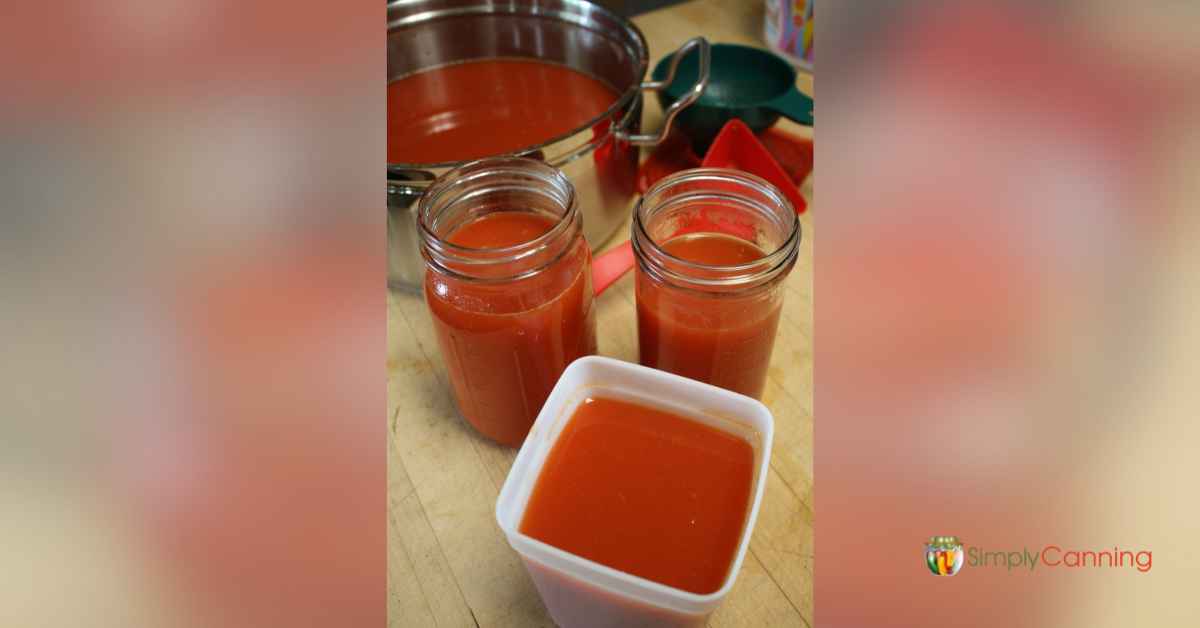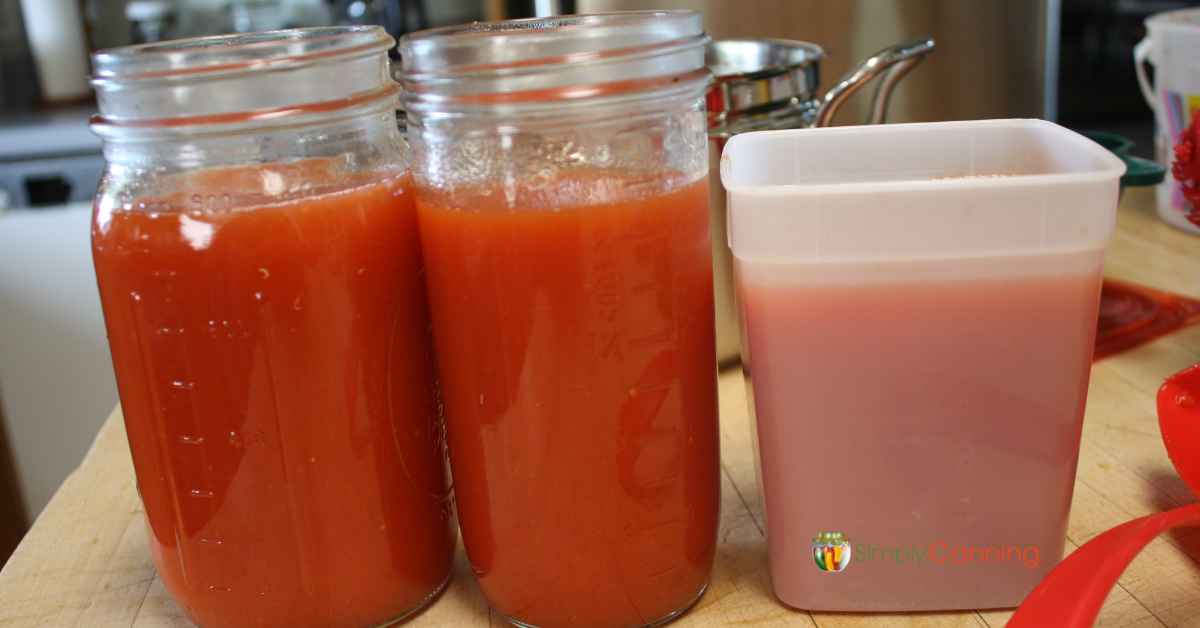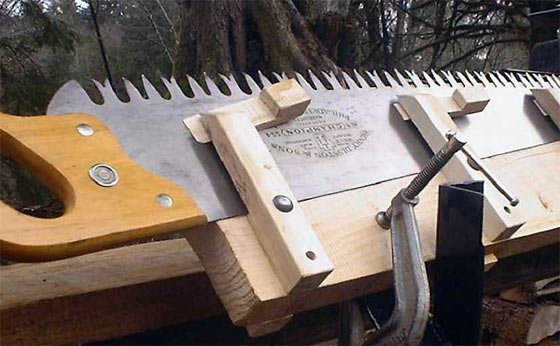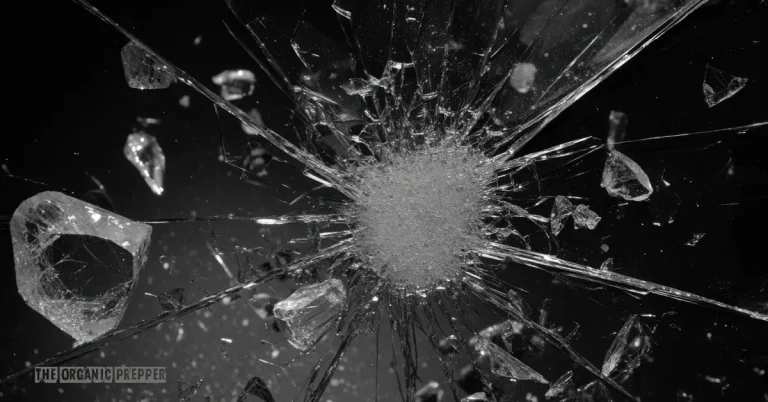Freezing tomatoes is a great way to preserve tomatoes for the off-season. However, freezing them as tomato sauce saves space and makes it more convenient to use later.
In this article, I’ll show you how to prepare fresh tomatoes into a sauce for freezing in bags or other freezer containers. Let’s get started!
Extended Directions & Tips for Freezing Tomato Sauce
Quantity & Yield of Tomatoes
Like many recipes, it is tricky to estimate how much sauce your tomatoes will make, especially if they are very juicy. The beauty of freezing tomato sauce is that you don’t need to worry as much about having enough to fill all of your jars, so it isn’t that big of a deal. But an estimate of about 5 pounds per quart is close.
Making Tomato Sauce for Freezing
Wash tomatoes and remove stems and bruised bits if needed. Cut out the core. (the stem area)
Next, it’s time to prepare whole tomatoes into a sauce. There are several different ways to do this. Some remove peels and/or seeds. Some you can just make a sauce and freeze it just as it is or reduce it and thicken it up into a tomato paste.
Let’s walk through a few of them! This is a very similar process to those I use for canning tomato sauce.
A couple short notes on the options to remove seeds or skins.
- Consider what you think you’ll be using the tomatoes for. Do you often make tomato soup? You might like to remove both seeds and skins to make a nicer presentation. Do you use these for chili or stew? Then leaving the seeds might be no problem. It’s personal preference.
- Since we are freezing, peeling your tomatoes is optional. But the skins turn into these tiny little rolled up slivery things if you don’t. Can you tell I don’t like it?! It is unappealing in just about any dish. I recommend peeling the tomatoes for any of these methods. But like I said, it is optional.
Peel and Mash to Make Tomato Sauce
The first option is the lowest-tech option and removes skin but not seeds. To begin peel your tomatoes. Blanch tomatoes about 30-60 seconds in boiling water or until the skins split. Drop the tomatoes immediately into cold water to stop cooking. (A blancher makes this easier!)
Slip off skins, quarter tomatoes, and strain off extra juices if desired. (Straining is optional, but it does make a thicker sauce.) Put resulting skinless tomatoes into a pot and mash with a potato masher. You could also puree with a stick blender.
(For details about how to blanch tomatoes check this canning tomatoes page.)
Making Tomato Sauce in a Food Mill
Another option that removes both seeds and skins is to run your tomatoes through a food mill, which will strain out the solid bits and allow the rest of the fruit to press through into a nice sauce. This makes the highest quality, smoothest tomato sauce possible.
To do this, slice tomatoes in half and simmer on the stove until somewhat soft, about 15 to 20 minutes. Once cooked, run the tomatoes through a food mill.
Making Tomato Sauce with a Blender
Finally, another option is to put raw sliced tomatoes into a blender and whirl them all up together–seeds and all. This is not my preference but the pro is – It’s quick! I believe it will give a lower quality sauce. The skins will be there in little rolled up slivers. I don’t care for that, but since you’re freezing it, it is safe and very quick. Some people say the seeds may make your sauce bitter. I haven’t noticed this but keep it in mind.
Making Thicker Tomato Sauce
Separate the juice from the meat of the tomatoes.
This works really well if you’ve frozen your tomatoes (I use one gallon bags) and then taken them out of the freezer. As the tomatoes thaw, the clear juices naturally separate. I do this often.
- Freeze tomatoes in freezer bags.
- When I’ve got enough for freezing I take them out and peel each one by running them under hot water. (I’ve got a video of me peeling frozen tomatoes here) It’s super old… and I’m so young!) This makes the skins slip right off just as if you were blanching them.
- Then place the tomato in a strainer. (pictured you see my vintage food mill but any strainer works.)
- The tomato thaws, the meat stays in the strainer, and the juice runs out.

Simmer to Reduce
Heat the sauce to a simmer and allow to cook until reduced. I’ve also used a crockpot for this step. Just place the sauce in a slow cooker, leave the lid off or pushed to the side to allow steam to escape Very similar to what you’d do with a fruit butter. . When it is thick to your liking it is ready to freeze.
Use a Paste or Sauce Tomato
Use Roma or other meatier tomatoes, which don’t have as much juice as other varieties. There’s a reason these varieties are known as “sauce” tomatoes!
Seasoning Your Sauce
This is the time you can add spices and seasonings to your sauce if you like. Keep it plain or make a marinara sauce. You could add salt, and pepper, oregano, fresh basil whatever you like. If you make a lot of pasta sauces you could also stir in some chopped peppers, onions or garlic.
Tomato sauce recipes for the freezer have much more leeway and can include fresh herbs or whatever ingredients you like. Canning is a different story. Learn how to can tomato sauce here.
Freezing Tomatoes in Freezer Containers or Bags
So now that you have your nice thick (or thin) tomato sauce you simply put the mixture in freezer containers, label the bag and put them in a freezer. Here you’ve got a couple options for packaging. You can use an size that fits what you’ll use in batches. I prefer about quart size.
- Freezer Jars – This is actually my least favorite option. I’m telling you about it because it can be done… but there is a higher risk for breakage plus the mason jars take up so much room in the freezer. I’ts up to you. If you do use glass jars, Leave a healthy headspace room for expansion. It’s preferable to use freezer jars with the straight sides like this. These I linked to are pint size. Ball used to make a larger style with straight sides. But they stopped making them. Much to my dismay! I love those jars for drinking, fermenting and other things.
- Freezer Bags – Make sure these are labeled for the freezer, not just storage. Freezer bags are probably the easiest but are generally not reused. (Unless you are like me and wash your plastic bags! Then you can use them a few times.) They stack nicely in the freezer too.
- Freezer Containers – These are simply plastic containers. I have and like these Ball brand containers… and these simple small square containers for smaller amounts.


Frequently Asked Questions on Freezing Tomato Sauce
Tomato sauce freezes very well! Freezing doesn’t really impact the flavor or texture, since it is already heavily processed by the time it is frozen.
I put the bags of frozen tomato sauce into the fridge for a day or two before use. In a pinch, you can also thaw in cold water in under 2 hours. (Make sure water is less than 7 degrees F.) If you’re making a sauce, you could always just thaw it on the stove too.
Homemade tomato sauce may be stored in the freezer for about 8 months for the highest possible quality.
I think it really depends on what you have available. My preference is [INSERT YOUR PREFERENCE].
Before You Go…
There are SO MANY things you can do with tomatoes, especially once you start canning them! I have lots of recipes for canning tomatoes on this page.
In addition, you make homemade ketchup with prepared tomato sauce too. Better for you than store-bought ketchup!
Recipe Card
Sources:
- https: //nchfp.uga.edu/how/freeze/vegetable/freezing-tomatoes/#gsc.tab=0
- https: //www.simplycanning.com/canning-tomato-sauce/
- https: //nchfp.uga.edu/how/freeze/freeze-general-information/thawing-and-preparing-foods-for-serving/#gsc.tab=0
- https: //food.unl.edu/article/freezing-tomatoes


















